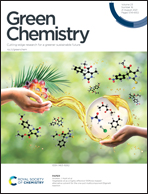Deep eutectic solvent assisted zero-waste electrospinning of lignin fiber aerogels†
Abstract
We developed a novel electrospinning strategy, using choline chloride–lactic acid (ChCl–LA) deep eutectic solvent (DES) as an electrospinning solvent to produce lignin fiber aerogels (LFA). The novel strategy is sustainable and cost-effective because no toxic or flammable volatile organic solvents were used and the precursors and waste were designed to be recycled. The fabricated LFA has the appearance of a piece of cotton, and the specific mass was calculated and found to be as low as 3 mg cm−3 with a porosity of over 99.7%. After stabilization and carbonization at a high temperature, the LFA can transform into lignin-based carbon fiber aerogels (LCFA). The LCFA has a high specific surface area (580 m2 g−1) and conductivity, and can be used as an electrochemical electrode material. We made supercapacitor electrodes using the LCFA, the specific capacitance of which is 155 F g−1, much higher than that of commercial multi-wall carbon nanotubes (39 F g−1) at a current density of 0.5 A g−1. The LCFA also have a high electrochemical cycling stability. For the supercapacitor electrodes, only a 2% decrease was observed after 5000 cycles. Moreover, all waste in this work was recycled and reused five times to achieve electrospinning with almost no waste.



 Please wait while we load your content...
Please wait while we load your content...